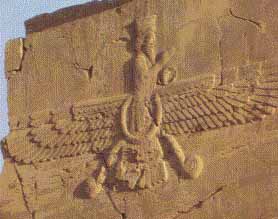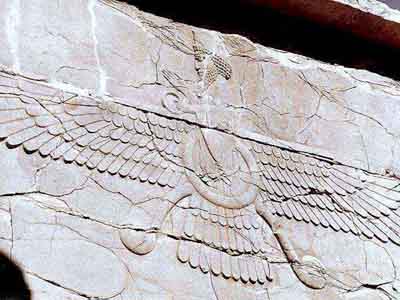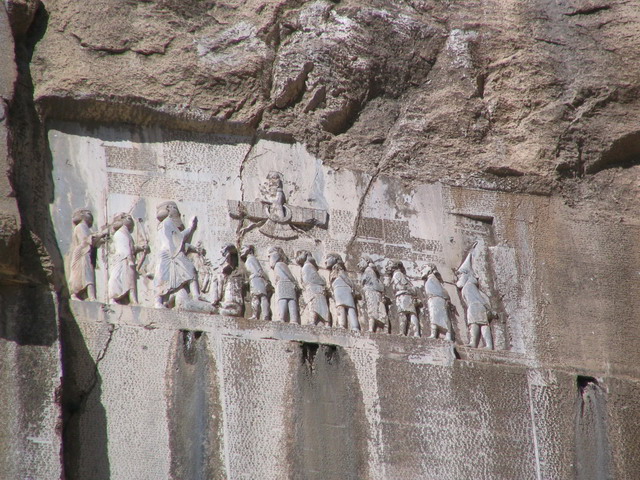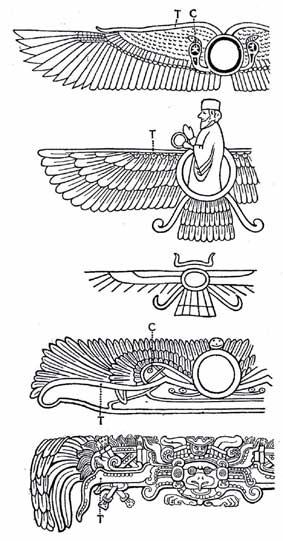
Posted on 11/11/2007 2:24:09 PM PST by blam
Median era ring discovered in Iran
Sat, 10 Nov 2007 09:56:15

A Faravahar, a symbol of Zoroastrianism
A unique ring belonging to the Median era adorned with a carved Farvahar, a symbol of Zoroastrianism, has been found in western Iran.
Archeological excavations in Iran's western province of Lorestan resulted in the discovery of a ring which dates back to the Bronze Age and is decorated with a symbol of Zoroastrianism.
The figure in the Farvahar is wearing Mede attire and a hat. The long-bearded man is facing the left as he emerges from the Sun. Wide open wings are seen on the two sides of his body. Two moving feet can also be seen on the ring.
The ring, which is 2.5 cm in diameter, is made of a type of bronze which is an alloy of copper, tin and zinc.
Some other relics including bronze necklaces, rings and bracelets as well as metal arrows and daggers were also found during the excavation.
The Medes were ancient Iranian dwellers who inhabited the northwestern parts of present-day Iran. They established their dynasty in the second half of the 7th century BC.

Faravahar or Farohar, Zoroastrian Symbol Color reconstruction from Persepolis
The Faravahar, or Farohar, is to remind one of the purpose of life on this earth, which is to live in such a way that the soul progresses spiritually and attains union with Ahura-Mazda (the Wise Lord); this state is called Frasho-kereti in Avesta.
In the center of the figure is a circle which represents the soul of the individual. For the soul to evolve and progress, it has two wings. In each wing there are five layers of feathers. These remind one of the five jzhirums with which the soul is linked. To achieve the ultimate goal of reaching Ahura-Mazda, the soul has to pass through all the jzhirums. The five layers can also represent the five Divine Songs (Gathas) of Zarathustra, the five divisions of the day (Gehs), and the five senses of the human body.
In nature, there exist two opposing forces: Spenta-Mainyu the good mind or assar-i roshni and Angre-Mainyu the wicked mind or assar-i tariki. A continuous conflict goes on in nature between these two. A person's soul is caught between the two and is pulled by each from side to side. The two long curved legs on either side of the circle represent these two forces.
To help the soul balance itself between these two forces, the soul is given a rudder in the form of a tail. This tail has three layers of feathers, which reminds one of the path of Asha Humata (Good Thoughts), Hukhta (Good Words), and Hvarasta (Good Deeds), or Manashni, Gavashni, and Kunashni by which the soul is able to make its own spiritual progress.
The head of the figure reminds us that Ahura-Mazda has given every soul a free will to choose either to obey divine universal natural laws or to disobey them.
The figure also has a pair of hands which hold a circular ring. The ring symbolizes the cycles of rebirths on this earth and other planes which the soul has to undergo to make progress on the path of Asha. If these divine laws are obeyed through Manashni, Gavashni, and Kunashni, our soul will be able to attain union with Ahura-Mazda. This far-off event, towards which the whole of creation moves, is called Frasho-kereti.
Awesome! What an excellent find! However the Median cap was a soft round cap, while the Persian cap was the “crown”-like hat.


Interesting ..?? Aren’t the wing positions very similar to the emblem the Nazi’s used ..?? It just looks familiar.
You might check the Roman Imperial Eagle. The Third Reich Eagle is derived from the German Imperial Eagle, which again stems from the Roman Empire.
The Zoroastrian/Persian Farvahar resembles the Ancient Egyptian winged sun:
http://en.wikipedia.org/wiki/Winged_sun
 |
||
| · join · view topics · view or post blog · bookmark · post new topic · | ||

|
||||
 |
||||
http://photo.livevideo.com/photo/A5FBB82387044C6E9B24DB1FBDDDB4F8/sumerian-writing-winged-disk.aspx
|
|
|||
Gods |
Thanks Blam. |
||
|
· Mirabilis · Texas AM Anthropology News · Yahoo Anthro & Archaeo · · History or Science & Nature Podcasts · Excerpt, or Link only? · cgk's list of ping lists · |
|||

A Sassanian knight, or clibanarius, with a standard bearer.
Well .. I never put much stock in anything from wikipedia - but you may be correct about the Romans - however, if you go back further into Hitler’s obsession with the occult - I still wonder if he used the middle eastern symbol - somehow believing it would have more power.

The typical Egyptian symbol from the lintel of a Theban temple of fifteenth century B.C. A Persian variant. An even more conventionalized Babylonian form. Two Central American (Maya) lintels.
Plato PrehistorianPerhaps three-fourths of the original Zend-Avesta... is believed to be lost... The Avesta was not written down until the Sassanian period (the third to seventh centuries A.D.)... Zarathustra's Gathas are particularly obscure... Not only do the Gathas appear to be a good deal older linguistically than even the oldest parts of the Younger Avesta, but the same characters who speak and act with immediacy... are represented in the Younger Avesta as belonging to a remote past... The Fravardin Yast [of the Younger Avesta] ...contains references to Iranian peoples who were apparently unknown to the earliest Achaemenid records of the sixth century B.C. And with the single exception of "Ragha," believed to be ancient Rayy near Tehran, no allusion is made to a known Iranian city or village... A generic use of the prophet's name might also explain the occasional indications in ancient literature that there was more than one historical Zarathustra. Pliny, for example, when referring to the Zarathustra born 6,000 years before Plato, remarked that "it is not so clear whether there was only one man of this name, or another one later on."
by Mary Settegast
[pp 212-214]
Map, Mitanni and Assyria
Capital City Of Ancient Superpower Discovered (Medes)
Independent (UK) | 10-26-2002 | David Keys
Posted on 10/26/2002 3:56:48 PM EDT by blam
http://www.freerepublic.com/focus/news/776390/posts
blam quotes some source regarding Hittites, Indoeuropean, Mitanni, etc:
http://www.FreeRepublic.com/forum/a3afd84936a40.htm#7
Lycian Influence To The Indian Cave Temples
The Guide to the Architecture of the Indian Subcontinent
spring of 2000 | Takeo Kamiya
Posted on 07/12/2005 1:37:19 AM EDT by SunkenCiv
http://www.freerepublic.com/focus/f-chat/1440990/posts
http://www.freerepublic.com/focus/f-chat/1440990/posts?page=17#17
reference to a single tablet from the Amarna archive, containing the only surviving readable text attributed to Mitanni:
http://www.freerepublic.com/focus/f-chat/1557568/posts?page=24#24
Unearthed: The Humble Origins Of World Diplomacy (Hittites)
Independent (UK) | 1-19-2003 | David Keys
Posted on 01/18/2003 5:51:58 PM EST by blam
http://www.freerepublic.com/focus/f-news/825168/posts
spectacular post on the Eltanin impact:
31 posted on 01/21/2003 2:20:53 AM EST by Light Speed
http://www.freerepublic.com/focus/f-news/825168/posts?page=31#31
those who visit the image link here:
http://www.goldenageproject.org.uk/images/slides/5-examples-winged-discs.jpg
will then be able to see it up there. :’) Must be their server blocks so-called parasitic links.
Disclaimer: Opinions posted on Free Republic are those of the individual posters and do not necessarily represent the opinion of Free Republic or its management. All materials posted herein are protected by copyright law and the exemption for fair use of copyrighted works.